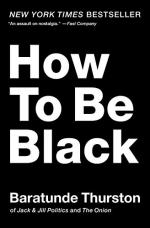|
This section contains 685 words (approx. 2 pages at 400 words per page) |

|
How to Be Black Summary & Study Guide Description
How to Be Black Summary & Study Guide includes comprehensive information and analysis to help you understand the book. This study guide contains the following sections:
This detailed literature summary also contains Topics for Discussion on How to Be Black by Baratunde Thurston.
The following version of this book was used to create the guide: Thurston, Baratunde. How to Be Black. HarperCollins, 2012.
Part memoir and part self-help guide to navigate race relations in the United States, Baratunde Thurston’s book, How to Be Black, discusses conceptions about blackness. The book begins with a list of things to do for Black History Month of which one would be purchasing his book. And by purchasing his book, one can go beyond the empty symbolism of briefly choosing an African-American cultural item as a feel-good connection and begin a more constructive conversation about race relations in the United States.
Thurston openly admits that the experience of blackness is far greater than his one essay collection. He uses his own name, Nigerian for “one who is chosen,” as a discussion point. Baratunde brands him as too black in a white context, but not black enough in a Nigerian one. Thurston, and a Black Panel that he has assembled for the purposes of this book, comment upon their realizations of being black, too black or not black enough—or, in the case of the one white panel member, comments upon whiteness. Thurston’s progressive activist mother, Anita Thurston, shapes his early identity. She also keeps him involved in numerous after-school activities and away from the drug-related crime in their neighborhood.
Thurston has several essays that examine the complexities of identity. He recounts his exposure to the word “oreo” to describe a person who is black on the outside but white inside, and that his father died a stereotypical death by a gunshot wound during a drug deal. Thurston begins his personal journey of discovery through his mother’s tutelage and through a black education program that taught an honest history of African-Americans in the United States. His own activism makes him critically aware of white students’ ignorance with black issues, such as a white student at the Sidwell Friends school who wonders why there is not a white student union—which is, in reality, the whole school—since there is a black student union.
His self-help structured essays, such as “How to Be The Black Friend or “How to Be The Black Employee” are satirical looks at the hyper-visible and multiple roles to be played. Each situation finds a black person within a white space and being a go-between in race relations and walking a fine line between invisibility and hyper-visibility; for example, drinking an appropriate amount of alcohol at a company party so as not to be considered smug nor threatening. Contradictory experiences abound for the black friend, employee or spokesperson, leading to the ultimate advice on being the next black president: just be perfect.
With such complexities in roles, Thurston asks the panel, “Have You Ever Wanted to Not Be Black”? Most answer that there were times in their lives where the struggle of discrimination and the pressure within the black community to be a certain way was demanding and they knew their lives would be easier if they were not black, but being black expanded their political consciousness. In the essay “Going Back to Africa,” Thurston visits Goree Island in Senegal, a shipping point for many abducted Africans before brought as slaves to the Americas. The trip humbles Thurston, and when asked of his interests from a Navy recruiter at a college fair, he keeps repeating,” But I Don't Want To Kill People.”
Thurston attends Harvard University, falling in love with the campus and university, but finds Boston racially divided and unfriendly. His experience at Harvard is largely positive, though financially challenging, and after graduation he works in telecommunications in the corporate world. Thurston finds his calling as all the panel members also do—using media to discuss race relations. The panel and Thurston explain that post-racial America is a myth, that racism exists and must be confronted daily by black people. The last essay explores the future of blackness where black history is taught with honesty, people of all races join the fight against black oppression, and all black people are encouraged to be who they are.
Read more from the Study Guide
|
This section contains 685 words (approx. 2 pages at 400 words per page) |

|



